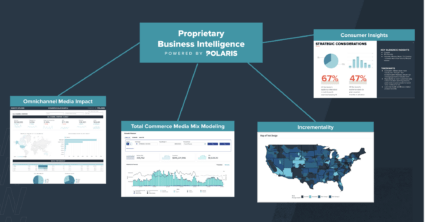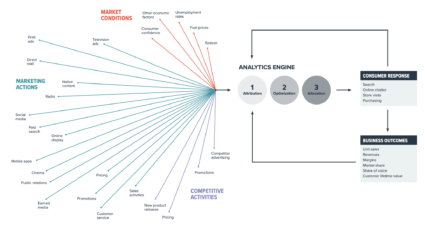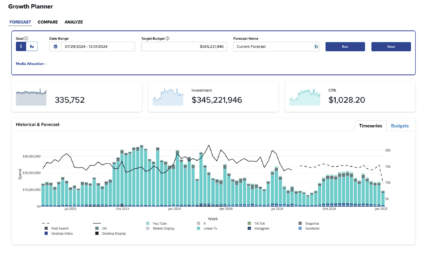With data privacy changes, periods of economic uncertainty, and increasing media convergence, marketers have had a challenging few years. Teams are under increased pressure to produce tangible results and make the case to finance and the C-suite for every marketing dollar. Marketers need to achieve both short-term revenue objectives and longer-term goals of brand preference.
Brands need to be able to prove that case with better measurement that doesn’t just track marketing KPIs, but how those efforts translate into total business impact. That’s easier said than done, especially for brands with sales goals across multiple points of distribution, including any combination of D2C, retail brick and mortar, third-party retail, and social commerce: what we call “total commerce” revenue goals.
White Paper
From Silos to Synergy: Harnessing the Power of Media Convergence
As consumer behavior and media platforms converge, your brand needs to say so long to siloed thinking.

For brands with total commerce objectives, retail media has entered the chat in a big way. The rise of retail media and its ever-changing growth projections has more and more teams within organizations investing in media in some capacity–not just the marketing team. That’s led to gaps in overall marketing visibility across media types.
Organizational silos are a big driver in that lack of visibility, as different parts of media investment are fragmented into unique teams with unique objectives (think sales teams managing retail media programs or brand marketing teams focusing on driving sales at retail through local awareness-based media). When those teams aren’t communicating effectively, you’ve got a recipe for disconnected, inefficient measurement.
With these silos, you can’t link media impact to overall outcomes. For example, how can you measure whether your D2C media is driving retail sales, if those are in two different parts of your company?
When measured individually, each marketing program may look great (or not so much), but that doesn’t necessarily translate to the same results overall. This siloed view of media impact is incomplete and could lead to inaccurate decisions on media investment.
So how can you get the data you need to prove your marketing’s value in the context of overall business performance? The solution is an integrated approach to measurement.
Integrated measurement frameworks can prevent missed opportunities for more performance, creative, and personnel resourcing.
Building integrated measurement solutions
To make integrated measurement a reality, you first need to define the objectives you’re trying to solve. Sticking to traditional marketing KPIs may work for day-to-day marketing managers, but connecting those metrics to the bottom line is critical for executive-level investment and company performance conversations.
To get the data you need to fuel a truly holistic media strategy, you’ll need an integrated data strategy. This involves a unified tagging strategy across all media investment opportunities by channel, tactic, ad format, creative, and audience to get granular insights into how individual components of a media mix are performing. But the real unlock is when these data points are integrated into a unified media mix model (MMM) that can showcase brand marketing’s impact on the total business.

With MMM, you can understand cross-channel lift across all your marketing efforts against different response variables, including D2C sales, retail sales, Amazon sales, or total commerce. You can use this data to scenario plan to different goals, and investment scenarios, as well as see points of diminishing returns. Integrating additional business drivers like distribution, trade, and promotions can help you see media impact relative to other factors in achieving sales goals.
MMM can also be used to understand media impact on other objectives like brand awareness and preference. You can integrate macroeconomic factors to understand broader impact; for example, for CPG you might account for the consumer price index for certain categories or financial services interest rates to help you understand the impact of those forces on your business. Competitor media investments can also be incorporated broader context.

Source: Harvard Business Review
Traditional MMMs have their downsides–they can be expensive and slow, and they take years of data to set up. But there’s a solution to that problem: high-velocity MMMs (like Wpromote’s Polaris Growth Planner), which speed up the process by leveraging increased data availability and automation so measurement doesn’t rely on individual data.
With a robust model in place, brands can start to make media optimization decisions that can impact individual commerce points or total commerce outcomes. For example, if CTV and YouTube both achieve individual commerce objectives (D2C or retail), but one of those tactics impacts both, you can gain efficiencies by consolidating your investment into the tactic that lifts all ships.

By breaking down siloes between channels and getting a birds-eye view of your results and your marketing overall, you can maximize the impact of your investment.
Integrated measurement should also be accompanied by always-on incrementality testing to continue to evolve the model assumptions as business, consumer, and media dynamics change. Incrementality testing helps you find your marketing’s true impact by canceling out some of the noise; it removes conversions that would have happened anyway so you can see incremental growth. An incrementality testing framework can help you validate your performance data and get a better picture of the true lift in crucial KPIs and results.

